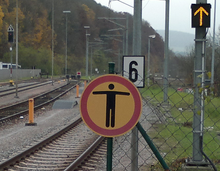Trip indicator

A travel indicator (also called a signal travel indicator , abbreviation SFA ) is a light signal that is located on or on platforms . It shows that separating the Zugaufsicht has (i d. R. of drivers.) When stopping at the station whether for his train the extendable or intermediate signal to drive is provided, because only in this case he can teach his train to Abfahrauftrag. Travel indicators are not signal-technically safe and are not a railway signal in the sense of the railway signaling order , but merely an orientation sign.
The trip indicator can also serve as an orientation for the driver if he cannot recognize the position of the exit signal from the stopping place. In this case, drive at a maximum of 40 km / h until the main signal is recognized and ensure that the train can be brought to a stop in front of the signal if it is not in motion.
The term "travel indicator" is also often incorrectly used for the train destination indicator. This is a customer information display on the platform that provides information about the departure time, the destination and, if applicable, the route and special features of the next train.
Locations
The train supervisor may only dispatch a train if they can see that the signal for the train is on. In many cases she can observe the main signal at the end of the platform. However, if this signal is not or only difficult to see for the train supervisor, because it is either covered (e.g. if the signal is behind a curve or not on the side of the train on which the platform is located) or too far away tachographs are installed on the platform . This enables the train supervisor to infer the position of the signal without being able to see it directly.
Signal aspects
The travel indicator shows a diagonally arranged, illuminated strip or three illuminated points when the main signal is on travel . If the signal is on stop , the travel indicator is dark.
An illuminated bar rising from the bottom left to the top right indicates that the exit in the direction in which you are looking at the indicator is free. If three illuminated points can be seen falling from the top left to the bottom right, the signal behind the viewer is set to travel .
Switzerland
In Switzerland, the driving service regulations define the so-called driving position indicator, which can be viewed as an analogy to the driving indicator. This, however, shows a completely different signal pattern: when it is illuminated, an orange or white arrow pointing upwards can be seen.
Since this signal only indicates that the exit signal shows a driving concept, an exiting train may only travel at a maximum of 40 km / h until the next main signal. Due to the signal technical coupling between exit signal and proceed indicator has no signal at danger expected, but from the lowest possible driving term be assumed Fb2 (Vmax 40 km / h).
The signal image of the trip indicator valid in Germany is very similar to the auxiliary signal type L valid in Switzerland , whose function is very similar to the German caution signal .
Waldshut train station
The travel position indicator in Waldshut train station is a specialty: Here is a Swiss signal in a train station that is otherwise subject to German signaling regulations.
The reason for this lies in the special operational situation of track 5, where trains arrive and turn from Koblenz in Switzerland. Journeys on this track are controlled from there.
Individual evidence
- ↑ Ril 408.2331 Section 3 Paragraph (1) a) ( Online )
- ↑ Ril 408.2341 Section 2 Paragraph (6) b) ( Online )
- ↑ Swiss Driving Regulations (FDV) A2016 Federal Office of Transport (FOT), July 1, 2016 (PDF; 3 MB). R 300.6, Section 3.6.1 / 3.6.2 Approval to travel without seeing the main signal in the station

